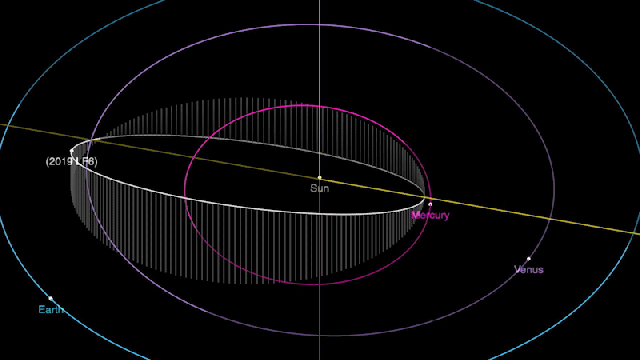Introducing 2019 LF6, an asteroid so close to the Sun that a year lasts only 151 days. Known as an “Atira” asteroid, its orbit falls entirely inside Earth’s orbit, making it one of only a small handful of these objects ever discovered.
A team of astronomers led by Quanzhi Ye from Caltech University in the U.S. found 2019 LF6 using the Zwicky Transient Facility (ZTF) at the Palomar Observatory in California, as noted in a press release.
This is an interior-Earth object (IEO), or Atira asteroid, having an orbit that fits entirely within Earth’s path around the Sun. In other words, 2019 LF6’s aphelion (farthest distance from the Sun) is still shorter than Earth’s perihelion (closest distance to the Sun).
Specifically, 2019 LF6 has an aphelion measuring 0.794 AU, in which 1 AU is the average distance of the Earth from the Sun. Earth’s perihelion is 0.983 AU.
2019 LF6 is noteworthy in that its perihelion measures just 0.317 AU (47.4 million kilometres), which takes it closer to the Sun than Mercury. This rock makes a complete orbit of the Sun in just 151.13 days, the shortest year of any known asteroid.
2019 LF6 is only the 20th IEO to ever be identified, but it’s already the second IEO discovered this year. In February, Yu’s team used the ZTF to discover asteroid 2019 AQ3, which, with a year lasting 165 days, was the previous record holder for shortest Atira year. These objects are exceptionally hard to detect, but these recent findings suggests there are more out there waiting to be found.
Fascinatingly, 2019 LF6 has some heft to it, with a diameter around 1.3 kilometres wide. The team came to this estimate by looking at the object’s brightness and ability to reflect sunlight (albedo), but Yu told Gizmodo that his team didn’t have enough data to determine its shape.
Only two of the 20 known Atira asteroids are bigger, including 163693 Atira, which is nearly 5 kilometres wide.
“You don’t find kilometre-size asteroids very often these days,” said Ye in the Caltech press release. “Thirty years ago, people started organising methodical asteroid searches, finding larger objects first, but now that most of them have been found, the bigger ones are rare birds,” he said. “LF6 is very unusual both in orbit and in size – its unique orbit explains why such a large asteroid eluded several decades of careful searches.”
By “unique orbit,” Ye is referring to this object’s position relative to our solar system’s orbital plane. Like the grooves on a vinyl record, most planets align along a flat disk. But 2019 LF6, and also 2019 AQ3, are in orbits “that take them well outside the plane of the solar system,” said ZTF team member Tom Prince in the press release, adding: “This suggests that sometime in the past they were flung out of the plane of the solar system because they came too close to Venus or Mercury.”
“Atira asteroids come from the main asteroid belt and find their way to their current orbits via gravitational perturbation by major planets,” Yu told Gizmodo. “Like other asteroids, Atiras are leftovers from the formation of our solar system.”
As noted, 2019 LF6 was discovered by the ZTF camera, which rapidly scans the sky at night. This instrument is well-suited for locating Atira asteroids, which feature very brief windows for observation.
The best time to look for Atira asteroids is during the twilight hours, around 20 to 30 minutes before and after sunset, when the camera can scan the vicinity around the Sun and not be blinded by its intense glare. But ZTF is also good at finding asteroids in general. To date, it’s found 100 near-Earth asteroids and around 2000 asteroids in the Main Belt between Jupiter and Mars.
The ZTF team is now awaiting NASA approval for the Near-Earth Object Camera (NEOCam), a proposed mission in which a spacecraft would use the camera to hunt for more IEOs.
“It is one of the near-Earth asteroid groups that we don’t know much about, since their unique orbits make them difficult to observe,” Yu told Gizmodo. “Therefore, we can improve our understanding of the inventory of near-Earth asteroids by studying the Atiras.”
